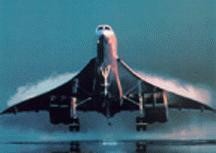| This page contains material that is kept because it is considered humorous. Such material is not meant to be taken seriously. |






Concordeism is the great reverence for, and often worship of, the Franco-British Concorde supersonic airliner. While the Concorde is undoubtedly an exceptional aircraft design, Concordians go beyond showing mere admiration for the aircraft.
Elements of Concorde worship
editConcorde worship manifests itself in various ways:
- Concordians treat the Concorde as more than just an aircraft, often referring to the aircraft as she, both individually and collectively.
- Some Concordians refer to the aircraft as their "friend", mirroring some other religions, such as Christianity, whose adherents sometimes refer to God or Jesus Christ as their friend.
- Also mirroring religious practice, Concordians do not use the article the when referring to the aircraft. For example, God, not the God; Concorde, not the Concorde.
- The more devout elements of Concordeism are not content with confining their peculiar grammatical usages to their own circles, but insist that everyone else also use their terms of reverence. This element of Concordism is very aggressive, and its adherents are often referred to as Concorde thumpers, a play on the term "Bible thumpers" sometimes used to deride aggressive Fundamentalist Christians.
- Before takeoff, a ritual is often performed to bestow good fortune on the aircraft and its passengers; usually involving the burning of an effigy of the Tupolev Tu-144, followed by the scattering of the ashes over the Concorde's landing gear.
- Committed Concordians in both France and the UK gather once a year on the summer solstice to pay homage to the designers of the Concorde. This day has been chosen as it provides the longest number of daylight hours in which to gaze lovingly and with total devotion at Concorde.
- Concordians recognise each other in two ways: the first involves a gesture in which the tip of the forefinger is placed between the eyes, while the tip of the thumb rests on the end of the nose forming a shape resembling that of the Concorde's nose. The second is a special handshake known only to those Concordians that have risen to the higher echelons within the order.
- Many Concordians believe that the "coming of Concorde" was foretold during Romans times, for when Julius Cesar went to Gaul (present-day France, where the Concorde was built), the prophesy "He came, he saw, the Concorde", was made.
The extremist elements of Concordeism have foresaken their prior religious affiliations to better worship their idol, and believe that the "Concordian calendar" should replace the Gregorian calendar, starting from Concorde's "birth" with previous years being suffixed "bC" (before Concorde). However, there are differences of opinion within the order as to what the precise commencement date should be. The fundamentalists argue that the year the initial design requirements were finalised should be "year 1", while the "liberal elements" maintain that the year in which the first prototype flew is more suitable. A small and growing number insist that the year the first commercial flight took place is fitting, and was when the Concorde "first truly came among us".